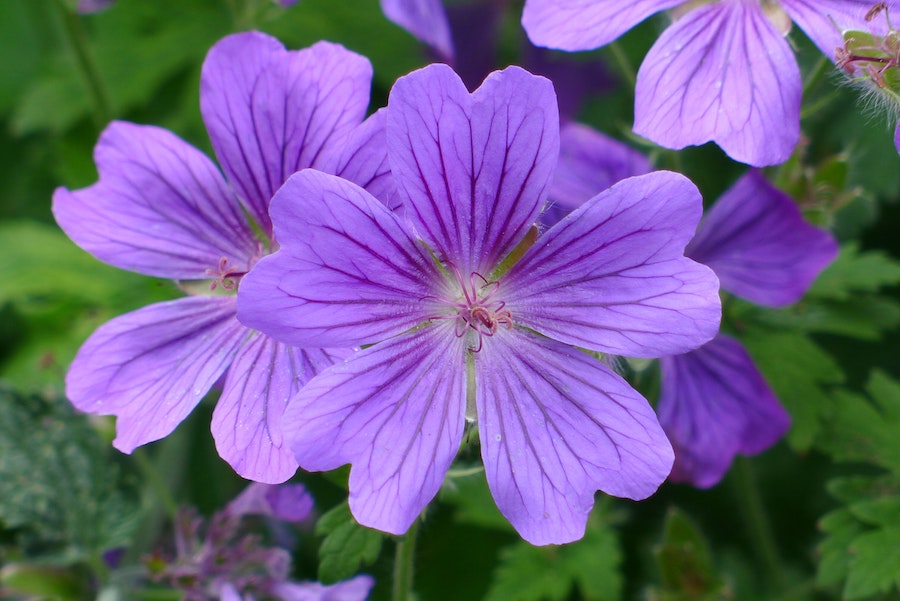Purple is the new black in the garden – but how do you include it in your scheme?
TV garden designers Harry and David Rich look at weaving purple into your garden scheme and the best plants to do it.
So, purple is the new black, if the swathes of lupins, irises, salvias and alliums which featured in the show gardens at this year’s RHS Chelsea Flower Show are anything to go by.

Award-winning garden designers Harry (left) and David Rich
Award-winning TV garden designer brothers Harry and David Rich, presenters of BBC One’s Garden Rescue and hosts of a new social competition with Amazon to find the most creative gardens this summer, reckon purple is among the coolest colours on the block.

Purple clematis set the tone
Harry explains: “Purple is fashionable because it is quite prominent and gives you a lovely depth in the garden but isn’t too garish.
“It can be easily blended with other plants. It does a lot of talking but it doesn’t talk too much. It complements other colours and it’s a good way of creating an informal garden with a punch.”
So, how can you weave this rich colour into your own garden scheme?
Put the right plant in the right place

Irises like moist soil
“The first thing to consider is the aspect,” says David. “You need to choose the right plants for the right position. Plenty of plants will tolerate shade such as wild geranium, but in a sunnier spot you could have perovskia (Russian sage) or lavender.”
Irises were featured in abundance at this year’s Chelsea Flower Show – they prefer full sun in a moist but well-drained soil, with plenty of added organic matter.
“They have a blousy flourish and then are over in a week,” David observes. “Some people might find them unnecessary but to have them poking up in a planting scheme just for that short spell can dramatically change the atmosphere, especially if you are using some of the bearded irises or even Iris sibirica ‘Tropic Night’, which can add so much depth to a planting scheme.”
Combine different shades of purple

Purple plants at this year’s RHS Chelsea Flower Show
Use purple foliage from plants such as Sambucus nigra, which has a very deep purple leaf and a soft pink flower, with softer, lighter purple hues. Play around with the contrasts of the two purples to emphasise the light colour against the deeper tone.
“The colour doesn’t stop at ground level. You can elevate the colour by using shrubs such as syringa (lilac) with its beautiful plumes of purple flowers,” says David.
“There’s a growing trend of using shrubs in the garden because they provide loads of interest and many of them require much less maintenance than ground-level perennials.
Try out smaller alliums
Alliums have been among gardeners’ favourites for more than a decade and are still fashionable, although some of the smaller ones are becoming more popular, compared with the huge varieties, says David.
“The trends are about depth of planting now. An allium is quite airy, with thin, wiry stems and doesn’t actually compete with anything, but sits among the planting scheme. It helps knit together a more natural planting scheme.”
Harry adds: “The reason alliums are used so much is that they are a very unique shape. Smaller ornamental varieties are becoming popular. The days have perhaps gone when people were using the blousy, more globular types.”

More blousy alliums aren’t as trendy as they once were
Allium sphaerocephalon, for example, is an alternative small-headed blackcurrant-hued type which flowers later than others.
Alliums make good partners for grasses, which have height and movement and hide the fading straggly leaves of the allium before it flowers. Grasses create a muted scheme below the allium flowers. Plant cow parsley as well and that will add shape and colour.
“When you lay alliums out in the bed, do it as a random scatter, so you are creating a cluster in the corner and then drifting them through, to drag the eye through the planting scheme without it being too forced,” David advises.
Contrast colours

Lavender and crocosmia flowers contrast well
Good contrasting colours for purple include orange, say the brothers. Combine purple plants with orange-hued achilleas, geum and trollius. Crocosmia also make good companions as their shades run from orange, to yellow, to red.
For a gentler scheme, combine different shades of purple in your border, perhaps with creams to soften the tone.
Think about architecture

Use lupins for architectural interest
This year there have been some striking purple lupins at the garden shows. If you plan to feature these architectural beauties in your garden, keep the surrounding planting simple, Harry advises.
“With something so dominant, plant something simple around it like Deschampsia flexuosa (wavy hair grass), keeping it airy and minimal, to allow the lupins to do the talking.”

Lupins make a bold statement
Salvias are also architectural gems, he says.
“They are unique in the way that they have lovely long spires of purple. One of our favourites is Salvia ‘Hot Lips’, but there’s also Salvia nemorosa and ‘Amistad’, which has larger leaves and delicate flowers. Salvias have many varied purple hues.

Salvias create a purple accent
“Use salvia as a base plant and make the most of the varieties of it. It’s about a combination of the same plant, knitted together through the variety of colour and leaf among like-minded plants. Certain species can deal with a bit more drought, which makes it easier to maintain in hot weather.”
Competition details will go live on Thursday on Amazon’s Facebook page at facebook.com/Amazon/
The Press Association
Latest posts by The Press Association (see all)
- 6 mind sports to exercise your brain and keep you sharp - December 20, 2024
- Quiz: What classic Christmas food or drink are you? - December 20, 2024
- Leftover turkey and watercress pie - December 20, 2024
- Catherine and William choose family shot for Christmas card photograph - December 19, 2024
- The best books to watch out for in 2025 - December 17, 2024




















